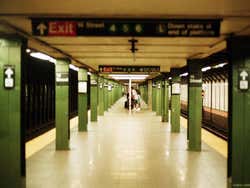
New York City Subway
The New York Subway opened in 1904 and is the longest metro system in the US and one of the world’s largest underground lines. It has nearly 500 stations and a total of 660 miles of tracks (1,060 km).
As a result of it being old, the metro stations are sometimes small and stifling. In addition, they don't tend to be very clean and quite frequently you'll see rats on the tracks.
Lines
The New York City subway has 28 lines whose names can be letters or numbers. They connect 4 of the city's 5 boroughs: Manhattan, Brooklyn, Queens and the Bronx, but not Staten Island. You can see the underground maps here:
Prices
The price of a single ticket on the New York subway is US$ 2.90. If you plan to use public transport frequently, we recommend paying with OMNY, as from the 12th trip onwards the weekly fare will be US$ 34.80. Until the end of 2026, you can still use the MetroCard, which is valid for the subway and buses.
Schedule
Both the subway and the bus system operate on a 24-hour basis. Nevertheless, not all the Subway station entrances are open all night nor do all lines run throughout the night.
Frequency
Normally, the subway lines run every 2 to 5 minutes during peak hours (from 6:30 am to 9:30 am and from 3:30 pm to 8 pm). During midday, they run every 5 to 10 minutes and between 5 and 15 minutes till midnight.
From midnight until 6:30 am, trains run approximately every 20 minutes.
Using the Subway in New York
An interesting thing about the New York subway is that different entrances of the same stop have different directions, that is to say, in many streets if you enter through the entrance on one pavement you go north (uptown), and on the other side you go south (downtown). We recommend checking the direction before getting off the metro so that you don't have to go back out onto the street. If you pay and then realise you've made a mistake, you'll have to pay again.
In addition to the direction and the entrance, another thing to keep in mind to understand how the New York subway works is that several lines can share the same track. That is to say, you may be on the platform and a train may be passing on your track, but it may not be the line you are waiting for. So, before you get on, always look for the name or letter of the train or pay attention to the public address system or the signs in the station.
Another important detail is to know that there are two types of trains: normal and express. Express trains do not stop at every station and are much faster, so they are very useful for travelling long distances.



